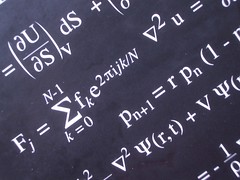 |
Just for fun I was thinking about how to classify Lie superalgebras of dimension 1|1, that is consisting of one even element and one odd element. The situation is similar, but different to the classification of 2 dimensional Lie algebras. Just to note, everything here will be over the real numbers. Also, I am sure this is well-know. |
Lie superalgebras
I will define a Lie superalgebra to be a Lie algebra with a \(\mathbb{Z}_{2}\)-grading. That is I have vector space for which I can assign some elements to be even and some elements to be odd. The Lie bracket is an even binary operation on the vector space \(V = V_{0}\oplus V_{1} \)
\([\bullet, \bullet]: V \rightarrow V\)
that satisfies
Skewsymmetry: \([x,y] = -(-1)^{\tilde{x} \tilde{y}}[y,x]\)
Parity: \(\widetilde{[x,y]} = \widetilde{x} + \widetilde{y}\)
Jacobi Identity : \([x,[y,z]] = [[x,y] ,z] +(-1)^{\tilde{x}\tilde{y}} [y,[x,z]]\)
where \(\tilde{x} = 0,1\) depending on if \(x \in V_{0}\) or \(V_{1}\). Things with parity zero are called even and things with parity one are called odd.
The 1|0 and 0|1 case
As a “warm-up” let us consider the case of just one even or one odd element.
Just from the closure of the Lie superalgebra we know that for one even element \(y\) the bracket has to be
\([y,y]= ay\),
for some real number a. However, the skewsymmetry forces \([y,y]= -[y,y]\) and so a=0 is the only possibility. In short we have a trivial abelian Lie algebra with one even generator.
What about the case with one odd element \(x\) say? Well the skewsymmetry does not help us here as \([x,x] = [x,x]\). But the closure and the parity of the Lie bracket forces
\([x,x]=0\).
To summarise, if we have one even or one odd element then the corresponding Lie superalgebras must be trivial, but for slightly different reasons.
2 dimensional Lie algebras
Just to recall the situation for 2 dimensional lie algebras we have two and only two such algebras up to isomorphism. They are denoted \(L_{1}\) which consists of two (even) elements that mutually commute \([x,y] =0 \), and \(L_{2}\) for which we have the non-trivial bracket \([x,y]=y\).
I will leave it as an exercise for those interested to prove this is the case. As a hint, start from \([x,y] = ax +by\) and you can show that under a change of basis you recover the two Lie algebras above.
The 1|1 case
Now to the main topic. Let \(x\) be odd and \(y\) be even. Then the only possibility for the non-trivial Lie brackets must be
\([x,y] = ax\) and \([x,x] = bx\),
from the parity of the Lie bracket. Now we need to look for consistency with the Jacobi identity. So,
\([x,[x,y]] = [[x,x],y] – [x,[x,y]]\).
This then means that we have
\(2 a[x,x] = 2 ab y =0\).
Note that I have not assumed that a is not zero at this stage and so all I can conclude is the ab =0.
Thus we have three generic cases;
i) \(a=0\) and \(b =0\)
ii) \(a \neq 0 \) and \(b =0\)
iii) \(a = 0 \) and \(b \neq 0\)
Then up to isomorphism (just a rescale of the basis) we have three Lie superalgebras whose non-trivial Lie brackets are
i) \([x,x]=0\) and \([x,y]=0\)
ii) \([x,x] =0\) and \([x,y] = x\)
iii) \([x,x] =y\) and \([x,y] =0\)
All three of these have nice geometric realisations and physicists reading this might recognise iii) in connection with supersymmetry.
The geometric realisations
By a geometric realisation I mean in terms of vector fields on some supermanifold. For these 1|1 dimensional examples it is quite illustrative.
Translations on \(\mathbb{R}^{1|1}\) are of the from
\(t’= t + a\)
\(\tau’ = \tau + \epsilon\),
where where we have picked global coordinates \((t, \tau)\) consisting of one even and one odd function. These translations are generated by the vector fields
\(X = \frac{\partial}{\partial \tau }\) and \(Y = \frac{\partial}{\partial t}\).
Thus we see that we have the trivial Lie superalgebra i).
Note that we have both even and odd parameters for these translations and so we are not really talking about the categorical morphisms as linear supermanifolds here. They are slightly more general than this.
With this in mind let us look at the Lie superalgebra of the diffeomorphism supergroup of \(\mathbb{R}^{0|1}\). The transformations here are of the form
\(\tau’ = a \tau + \epsilon\),
which are generated by the vector fields
\(X = \frac{\partial}{\partial \tau}\) and \(Y = \tau \frac{\partial}{\partial \tau}\).
Thus we have the Lie superalgebra ii).
The last case is more interesting for physics. Here we have the N=1 d=1 SUSY-translation algebra
\(t’ = t + \epsilon t\tau + a\)
\(\tau’ = \tau + \epsilon\),
which are generated by the two vector fields
\(X = \frac{\partial}{\partial \tau} + \tau \frac{\partial}{\partial t}\) and \(Y = \frac{\partial}{\partial t}\),
which up to a factor of 2 (we can rescale this away easily) we get the Lie superalgebra iii).
Conclusion
For dim 1|0 and dim 0|1 we only have the trivial abelian Lie superalgebras.
For dim 2|0 we have (up to isomorphism) two Lie (super)algebras.
For dim 1|1 we have (up to isomorphism) three Lie superalgebras.




